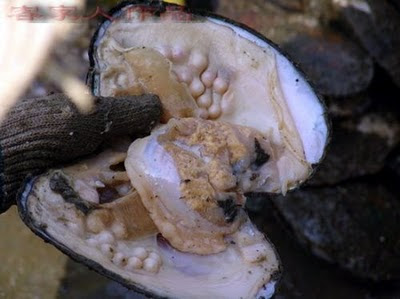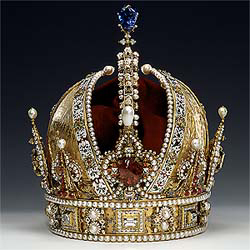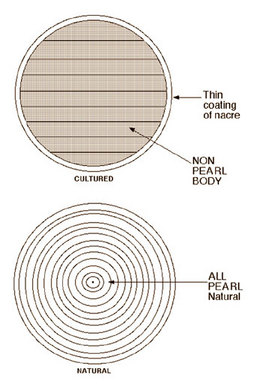Identifying Natural Pearls
It's a Difficult Distinction!
You can toil away like a galley slave identifying Natural Pearls from Cultured Pearls, but the sobering reality is, the only way to conclusively tell a true Pearl from Cultured pearls is by X-ray examination.
 Identifying Natural Pearls from other Pearl Varieties
Identifying Natural Pearls from other Pearl VarietiesIt gets even worse, the jewelry industry's standard manual on the identification of Natural Pearls states that the distinction between Natural pearls and Cultured pearls is the industry's most difficult distinction!
Grading Pearls, on the other hand, is a relatively straight forward process. There are some simple tests, you can do at home, that will give the lay-person, an indication if the pearl is natural or cultivated, although these tests are by no means conclusive. Some useful pearl identifying tests you can do at home can be found further down on this page.
Before the 1920s and the rising of the curtain of Mikimoto Pearls -pearl jewelry was usually set with either Natural Pearls, Freshwater Pearls or Pearl Imitations.
Pearl cheats have been around for centuries, they were just a little more discreet about it in the days of yore. Identifying Natural Pearls from Cultured pearls have perplexed even the experts. On the other hand, identifying Cultured Pearls from their imitations is not as difficult.
Many prospective pearl buyers, have limited knowledge about Pearls, and have not developed 'an eye for a pearl' because most people have never even seen a Natural Pearl in their lifetime!
Natural Pearl Jewelry is acquired mainly from estates and many Natural Pearls, single and in necklace strands remain in private hands.
Pearls are ranked low on the Mohs scale of hardness. Unlike diamond mined from the earth, pearls mined from sea are delicate and hence increase the Pearl rarity factor.
Despite their delicacy, Natural Pearls have survived since biblical times! Once upon a time in Jerusalem... there was a girl with a pearl earring (backed-up with with archaeological evidence!)...Read the astonishing true story Here...
 The Crown of Emperor Rudolf II is adorned with Natural Pearls. Circa 1602
The Crown of Emperor Rudolf II is adorned with Natural Pearls. Circa 1602This crown is embellished with enamels, rubies, diamonds, a solitary blue sapphire, and marine Pearls, lots of 'em, all Natural Pearls, adorn the crown of Emperor Rudolf II and dates to circa 1602!
Interesting to compare the crown with the Imperial Scepter of Austria, made by court goldsmith, Andreas Senbruck, in 1612; it echoes the decorative design of the crown and is embellished with Natural Pearls and a solitary blue sapphire.
Want more? Old information on Pearls can be found HERE...
Non-Conconclusive Identifying Natural Pearl Tests

A simple method towards identifying Natural Pearls, but not conclusive, is by checking the thickness of the nacre layers.
You can do this by rolling a strand of pearls on a white surface under a strong light. Thin-skinned Pearls will wink at you. They will appear brighter and darker as the Pearl is rotated. The winking is the bead showing through the nacre. Winking Pearls are usually not Natural Pearls.
Candling is another method to identify Natural Pearls. The Pearl is held over a concentrated light source or placed on the lens of a flashlight. A maglight is perfect for doing this test. In thick-skinned Pearls the bead will appear as a dark round smudge. A series of parallel stripes will be present in thin-skinned pearls. These stripes are growth layers. Pearls with these striations have very thin nacre and will therefore not be Natural Pearls.
Another simple test to help in identifying natural pearls comes to us from the pearl divers themselves. It's called - The Touch Test. The old pearl divers didn't call Natural Pearls, "cold flames" for nothing. If the Pearl in question is a Natural Pearl it will be cool to touch.
The touch test is a useful in identifying natural pearls set in antique goldwork, in which it's impossible to check the drill-hole for nacre thickness or perform the winking test that is useful for a strand of Pearls.
If you have a strand of Pearls you think and hope are Natural Pearls, these tests will give you an indication only and examination using a Jewelers loupe 10x is not enough to authenticate. Your pearls should be x-rayed at a gemological laboratory for identification.
Another Natural Pearl test is called the sun test. This test involves taking the strand of Pearls out into the sunlight. Unless they are very, very expensive, genuine Natural Pearls won't be perfectly matched under the sun. You will be able to see variations in their size, shape and color. If the Pearls are perfectly matched for size, shape, and color they will not be Natural Pearls.
Natural pearls are less transparent than Cultured Pearls. If you place a Natural Pearl against a dark background—like a box lined in black cloth—and put it under a strong light, the natural pearl will look like a small, white, homogenous ball with no discernible inner rings. When you do the same to a Cultured Pearl, you will see a thin brown line between the nacre layer and the nucleus of the Pearl.
Another way to help in your efforts of identifying Natural Pearls is by examining the Setting. If you see a Picasso in someone's home, you can be pretty sure it isn't the original piece of artwork. Similarly, you can gain valuable clues about the Pearl's authenticity by looking at its surroundings.
Natural pearls in antique settings may be mounted in gold, silver, or platinum. The setting and the age of the goldwork will provide clues to help you reach a conclusion and reach some kind of chronology.
Instruments for testing pearls is the pearl microscope (pearlometer) but the most efficient tests are done by the endoscope or a modern X-ray test called a SKIAGRAM or for undrilled Pearls, the lauegram.
However, sometimes identifying Natural Pearls from cultured Freshwater Pearls is nearly impossible. Sometimes you can't tell the difference and even X-raying the Pearls does not help. The nucleus, whether artificial or naturally occurring will decompose and usually leave a small void inside the pearl.
Natural Pearls can be almost any color, with rosy pink pearls and gold pearls at the top of the scale to jet black and blue-black or green-black that are very rare and highly prized. Oriental Pearls have a softer brilliance than the Australian Natural Pearls, which are mostly white.
Persian/Arabian Gulf Pearls remain one of the most sought-after types of Natural Pearls in the world.
Return to the top of Identifying Natural Pearls
Return to Natural Pearls
Return to Antique Jewelry Investor Homepage
